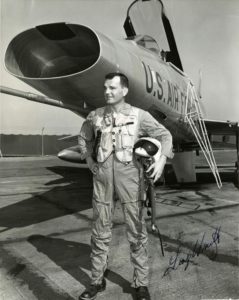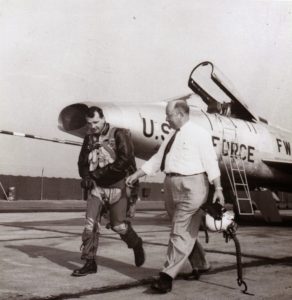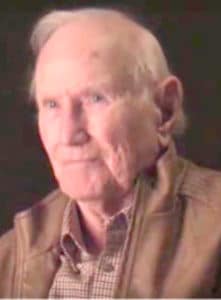
26 February 1955: Although it was his day off, North American Aviation production test pilot George Franklin Smith stopped by the office at Los Angeles Airport (today, known as Los Angeles International airport, or simply “LAX”, its international airport identifier). The company’s flight dispatcher told him that a brand-new F-100A-20-NA Super Sabre, serial number 53-1659, was sitting on the flight line and needed to be test flown before being turned over to the Air Force.
Smith was happy to take the flight. He departed LAX in full afterburner and headed offshore, climbing to 35,000 feet (10,668 meters) over the Pacific Ocean to start the test sequence.
But it was quickly apparent that something was wrong: The flight controls were heavy, and then there was a hydraulic system failure that caused the Super Sabre pitch down into a dive. Smith couldn’t pull it out of the dive and the airplane’s speed rapidly increased, eventually passing Mach 1.
Smith was unable to regain control of the F-100. He had no choice but to bail out. As he ejected, Smith read the instruments: the Machmeter indicated Mach 1.05—785 miles per hour (1,263 kilometers per hour)—and the altitude was only 6,500 feet (1,981 meters).
The force of the windblast hitting him as he came out of the cockpit knocked him unconscious. Estimates are that he was subjected to a 40 G deceleration. His parachute opened automatically and he came down approximately one-half mile off Laguna Beach. Fortunately, he hit the water very close to a fishing boat crewed by a former U.S. Navy rescue expert.
The F-100 dived into the Pacific Ocean approximately ¼-mile (0.4 kilometers) offshore between Dana Point and Laguna Beach.
 George Smith was unconscious for six days, and when he awoke he was blind in both eyes. After four surgeries and seven months in the hospital, he recovered from his supersonic ejection and returned to flight status.
George Smith was unconscious for six days, and when he awoke he was blind in both eyes. After four surgeries and seven months in the hospital, he recovered from his supersonic ejection and returned to flight status.
 Also on this day in 1968, Capt. Dale C. Sissell with the 90th TFS/37th TGS from Bien Hoa AB. He was shot down and ejected over Laos from his F-100D. He was rescued by a USAF Helo. That day, Capt Sissell sustained minor injuries.
Also on this day in 1968, Capt. Dale C. Sissell with the 90th TFS/37th TGS from Bien Hoa AB. He was shot down and ejected over Laos from his F-100D. He was rescued by a USAF Helo. That day, Capt Sissell sustained minor injuries.
Dale was shot down for a second time on March 6, 1968. He was severely injured the second time when he was forced to run from the enemy on a shattered leg, toward a waiting “slick” US Army chopper. He spent many months in an orthopedic hospital at Lackland AFB in Texas undergoing painful rehabilitation. When he was ready to fly again, he was sent to Elgin AFB to fly the F-104.
After 29 years in the USAF, Dale retired with the rank of Lt. Colonel in 1984.
To watch an interview with Dale Sissell go to https://www.youtube.com/watch?v=KsQnWCkFsvQ
